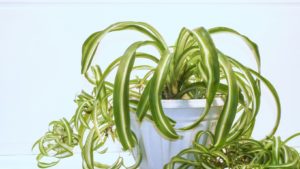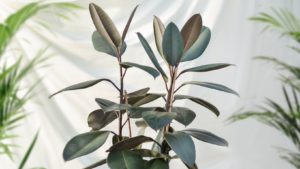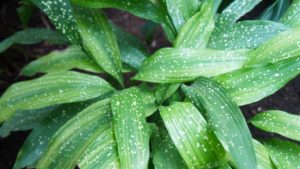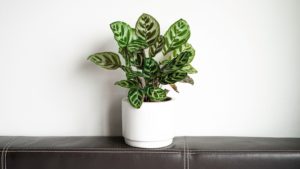Title: 10 Indoor Plants That Thrive in High Humidity Environments
Introduction
Indoor plants not only add a touch of nature to your home but also contribute to better air quality. For those living in high humidity environments, selecting the right indoor plants can make all the difference. These ten plants are not only beautiful but also thrive in the moisture-rich air of such conditions, turning your home into a lush, green paradise.
1. Peace Lily (Spathiphyllum): A Symbol of Beauty and Clean Air

The Peace Lily, scientifically known as Spathiphyllum, is a stunning and popular indoor plant appreciated for its elegant appearance and air-purifying qualities. Native to the tropical rainforests of Central and South America, the Peace Lily boasts broad, glossy, and deep green leaves that arch gracefully from the center of the plant. What sets it apart, however, are the iconic white, hood-like flowers that rise above the foliage, symbolizing purity and tranquility.
Uses and Benefits:
- Air Purification: Peace Lilies are renowned for their air-purifying capabilities. They filter out harmful indoor pollutants such as formaldehyde, benzene, and ammonia, creating a cleaner and healthier indoor environment.
- Improved Humidity: These plants naturally release moisture into the air through a process called transpiration. This makes them a fantastic choice for increasing indoor humidity levels, which can be particularly beneficial in dry or air-conditioned spaces.
- Aesthetic Appeal: With their striking white blooms and lush foliage, Peace Lilies add a touch of elegance and beauty to any room. They are often used as ornamental plants in homes and offices.
- Low Maintenance: Peace Lilies are relatively low-maintenance. They are forgiving when it comes to lighting conditions and don’t require frequent watering. This makes them an excellent choice for beginners or those with busy schedules.
- Peaceful Vibes: As their name suggests, Peace Lilies are often associated with tranquility and harmony. Many people find their presence calming and use them as decorative elements in spaces designed for relaxation or meditation.
- Compatibility: Peace Lilies are non-toxic to cats and dogs, making them a pet-friendly choice for households with furry friends.
How to Care for Peace Lilies:
- Light: Peace Lilies thrive in bright, indirect light. Avoid exposing them to direct sunlight, as this can scorch their leaves. However, they can tolerate lower light conditions, which makes them suitable for various indoor spaces.
- Water: Keep the soil consistently moist but not soggy. Water when the top inch of soil feels dry. Yellowing leaves can be a sign of overwatering, while drooping leaves indicate the need for water.
- Temperature: Peace Lilies prefer temperatures between 65-80°F (18-27°C). They are sensitive to cold drafts, so avoid placing them near doors or windows during the winter.
- Pruning: Trim yellow or brown leaves and spent flowers to encourage new growth and maintain the plant’s appearance.
- Repotting: Repot your Peace Lily every 2-3 years to provide fresh soil and space for growth.
In conclusion, the Peace Lily is much more than a decorative plant. Its ability to cleanse the air, improve humidity, and bring a sense of tranquility into indoor spaces makes it a cherished addition to homes and workplaces alike. With proper care, your Peace Lily can thrive, purify your air, and enhance the aesthetic and emotional qualities of your environment.
2. Boston Fern (Nephrolepis exaltata): Nature’s Green Elegance

The Boston Fern, scientifically known as Nephrolepis exaltata, is a classic and beloved houseplant cherished for its delicate, feathery fronds. This fern is native to tropical regions in the Americas and is famous for its lush, arching green foliage. Each frond consists of numerous leaflets, creating a lush, bushy appearance that adds a touch of natural elegance to any indoor setting.
Uses and Benefits:
- Air Purification: Boston Ferns are excellent air purifiers, helping to remove indoor pollutants and create a healthier living environment. They can filter out formaldehyde and xylene, common toxins found in indoor spaces.
- Humidity Regulation: These ferns are natural humidifiers. They release moisture into the air, increasing humidity levels, which is especially valuable in dry, air-conditioned, or heated environments.
- Aesthetic Beauty: The Boston Fern’s graceful fronds and vibrant green color make it a popular choice for enhancing the visual appeal of homes, offices, and indoor gardens.
- Versatility: These ferns can be grown in various containers, from hanging baskets to pots, making them suitable for different spaces and interior design styles.
- Low Maintenance: Boston Ferns are relatively easy to care for, making them a favorite among both novice and experienced plant enthusiasts.
How to Care for Boston Ferns:
- Light: Provide bright, indirect light for your Boston Fern. They thrive in filtered sunlight but can tolerate lower light conditions. Avoid direct sunlight, as it can scorch their delicate fronds.
- Water: Keep the soil consistently moist but not soggy. Water when the top inch of soil feels slightly dry to the touch. Mist the foliage regularly to mimic their natural humid habitat.
- Humidity: Boston Ferns appreciate high humidity levels. If your home is particularly dry, consider using a humidifier or placing a tray of water near the plant.
- Temperature: Maintain temperatures between 60-75°F (15-24°C). Avoid placing the fern near cold drafts or heat sources.
- Pruning: Trim yellow or brown fronds to encourage new growth and maintain the plant’s appearance. Regular pruning also helps prevent the fern from becoming too leggy.
- Repotting: Repot your Boston Fern every 1-2 years to refresh the soil and provide room for growth. Use a well-draining potting mix.
In summary, the Boston Fern is not only a charming addition to indoor spaces but also a natural air purifier and humidity booster. Its adaptability and low-maintenance nature make it a delightful choice for those seeking to bring a touch of green elegance into their homes or workplaces. With proper care, your Boston Fern will flourish, enhancing both the aesthetic and environmental qualities of your interior spaces.
3. Spider Plant (Chlorophytum comosum): Nature’s Air Purifier

The Spider Plant, scientifically known as Chlorophytum comosum, is a popular and visually striking houseplant. Its name comes from the arching leaves that dangle from the plant like spiders on a web. Native to South Africa, it has become a cherished addition to indoor spaces worldwide. Spider Plants are characterized by their long, slender leaves with creamy-white stripes, giving them a distinctive and appealing appearance.
Uses and Benefits:
- Air Purification: Spider Plants are renowned for their air-purifying qualities. They effectively remove common indoor pollutants like formaldehyde and xylene, promoting cleaner and healthier air.
- Low Maintenance: These plants are incredibly resilient and are an excellent choice for beginners. They can tolerate a bit of neglect and are forgiving of occasional missed watering.
- Adaptability: Spider Plants thrive in a variety of conditions, making them suitable for homes, offices, and indoor gardens. They can tolerate a range of lighting levels and are not overly demanding.
- Aesthetic Appeal: With their arching, variegated leaves, Spider Plants add a touch of visual interest and greenery to any space. They look fantastic in hanging baskets or on shelves.
- Non-Toxic: Spider Plants are non-toxic to pets, making them a safe choice for households with cats or dogs.
How to Care for Spider Plants:
- Light: Spider Plants can adapt to different lighting conditions. They do best in bright, indirect light but can tolerate lower light levels. Avoid direct sunlight, which can scorch their leaves.
- Water: Allow the top inch of soil to dry before watering. Spider Plants are somewhat drought-tolerant, so it’s better to underwater than overwater. Be sure to drain excess water from the saucer to prevent root rot.
- Temperature: Keep your Spider Plant in a room with temperatures between 60-75°F (15-24°C). They are sensitive to cold drafts, so avoid placing them near windows during winter.
- Humidity: Spider Plants can thrive in normal household humidity levels. However, they benefit from occasional misting or placing a tray of water nearby.
- Repotting: Repot your Spider Plant when it becomes root-bound, usually every 2-3 years. Use a well-draining potting mix and a slightly larger pot.
- Propagation: Spider Plants are easy to propagate. They produce “pups” or baby plants at the end of long stems. You can cut these pups and plant them in separate containers.
In summary, the Spider Plant combines stunning aesthetics with air-purifying prowess, making it a fantastic addition to any indoor space. Its adaptability, low maintenance requirements, and pet-friendly nature make it an excellent choice for both novice and experienced plant enthusiasts. With a bit of care and attention, your Spider Plant will thrive, bringing a touch of natural elegance to your surroundings while enhancing air quality.
4. Orchid (Orchidaceae): Elegance in Bloom

Orchids, belonging to the family Orchidaceae, are renowned for their unparalleled beauty and elegance. This diverse plant family boasts over 25,000 species, with each type exhibiting unique characteristics. Orchids come in an array of colors, shapes, and sizes, making them one of the most sought-after ornamental plants globally. Their intricate, often fragrant blooms have captivated plant enthusiasts and collectors for centuries.
Uses and Benefits:
- Aesthetic Appeal: Orchids are celebrated for their breathtaking, exotic blooms. Their distinct and intricate flower structures make them prized as ornamental plants, adding a touch of luxury and refinement to any setting.
- Air Purification: Orchids contribute to better indoor air quality by absorbing carbon dioxide and releasing oxygen, similar to other houseplants. While not as renowned for this trait as some other plants, they still provide these air-purifying benefits.
- Symbolism: Orchids hold deep cultural significance in various societies. They often symbolize love, beauty, luxury, and strength, making them popular gifts for special occasions.
- Longevity: With proper care, orchids can live for many years, offering a lasting source of beauty and elegance in your home or office.
- Variety: Orchids come in an astonishing array of species and hybrids, allowing you to explore different colors, shapes, and fragrances to suit your preferences.
How to Care for Orchids:
- Light: Orchids require bright, indirect light. Avoid exposing them to direct sunlight, which can scorch their delicate leaves and flowers. East or north-facing windows are often ideal.
- Temperature: Orchids thrive in moderate temperatures. Most common orchids prefer daytime temperatures between 65-75°F (18-24°C) and slightly cooler nights. Provide good air circulation to prevent mold and mildew.
- Water: Orchids need consistent but careful watering. Water them thoroughly but allow the top inch of the potting mix to dry before watering again. Overwatering can lead to root rot, while underwatering can cause stress.
- Humidity: Orchids often require higher humidity levels than typical indoor environments provide. You can increase humidity by misting the plant, placing a tray of water nearby, or using a humidifier.
- Potting Mix: Use a specialized orchid potting mix that provides excellent drainage. Repot orchids every 1-2 years or when they outgrow their containers.
- Fertilization: Feed orchids regularly during their active growing season (spring and summer) with a balanced orchid fertilizer. Reduce or cease feeding during their dormant period.
- Pruning: Trim away dead or yellowing leaves and spent flower spikes to encourage new growth.
Orchids require some attention and care, but their exquisite blooms and the sense of accomplishment you’ll feel as you nurture them make them a rewarding addition to your indoor garden. Whether you’re a seasoned orchid enthusiast or just starting, these stunning plants will bring elegance and natural beauty to your space, making them an enduring favorite among indoor plant lovers.
5. Bird of Paradise (Strelitzia reginae): Nature’s Tropical Elegance

The Bird of Paradise (Strelitzia reginae) is a captivating and instantly recognizable tropical plant. Its large, banana-like leaves and striking, crane-shaped flowers evoke images of lush, exotic landscapes. Native to South Africa, this plant has become a popular choice for indoor gardeners, bringing a touch of the tropics into homes worldwide.
Uses and Benefits:
- Aesthetic Marvel: Bird of Paradise is renowned for its dramatic foliage and vibrant, bird-like flowers. It serves as an eye-catching focal point in any room or garden, infusing a sense of the exotic.
- Air Purification: Like many indoor plants, Bird of Paradise contributes to improved indoor air quality by removing toxins and releasing oxygen. Its broad leaves can effectively filter pollutants, making it a healthy addition to your living space.
- Low Maintenance: Despite its tropical appearance, Bird of Paradise is relatively easy to care for, making it an excellent choice for both beginners and experienced indoor gardeners.
- Natural Divider: With its tall, arching leaves, Bird of Paradise can act as a natural room divider or screen, adding privacy and character to your space.
How to Care for Bird of Paradise:
- Light: Bird of Paradise thrives in bright, indirect light. It can tolerate some direct sunlight, especially morning sun, but avoid harsh, intense sunlight, which can scorch its leaves.
- Temperature: Maintain a warm and consistent temperature. It prefers daytime temperatures between 65-70°F (18-24°C) and slightly cooler nights.
- Watering: Keep the soil consistently moist during the growing season (spring and summer). Allow the top inch or two of soil to dry between waterings. Reduce watering in the winter when growth slows down.
- Humidity: Bird of Paradise appreciates higher humidity levels. Regular misting or using a humidity tray can help create the right conditions.
- Potting Mix: Use a well-draining, peat-based potting mix. Repot your Bird of Paradise every 2-3 years or when it outgrows its container.
- Fertilization: Feed your plant with a balanced, water-soluble fertilizer every 2-4 weeks during the growing season. Reduce feeding in the winter.
- Pruning: Trim away dead or damaged leaves to encourage new growth. You can also prune to control the size and shape of your Bird of Paradise.
- Repotting: When repotting, choose a container that’s only slightly larger than the current one to prevent overwatering.
Bird of Paradise plants may take some time to mature and produce their iconic flowers, but their striking foliage alone is enough to make them a captivating addition to your indoor garden. With the right care, these tropical beauties will thrive and bring a touch of paradise to your living space, reminiscent of lush, faraway landscapes.
6. Rubber Plant (Ficus elastica): A Resilient and Stylish Houseplant

The Rubber Plant (Ficus elastica) is a classic and versatile indoor plant that’s loved for its attractive, glossy foliage. Native to Southeast Asia, it has earned its place as a popular choice among indoor gardeners due to its adaptability and air-purifying qualities.
Uses and Benefits:
- Air Purification: Rubber Plants are champions at improving indoor air quality. Their large, sturdy leaves efficiently remove common toxins like formaldehyde, making them excellent additions to homes and offices.
- Aesthetic Appeal: With its deep green, leathery leaves and upright growth habit, the Rubber Plant adds a touch of elegance and sophistication to any space. It’s equally at home in modern, minimalist interiors as it is in more traditional settings.
- Low Maintenance: This plant is known for its hardiness. It can tolerate some neglect and is an ideal choice for busy individuals or those new to indoor gardening.
- Natural Divider: Due to its upright growth and dense foliage, the Rubber Plant can serve as a natural room divider or screen, creating privacy and defining spaces within a room.
How to Care for Rubber Plant:
- Light: Rubber Plants thrive in bright, indirect light. Avoid exposing them to harsh, direct sunlight, which can scorch their leaves. However, they can adapt to lower light conditions, making them versatile for various indoor spaces.
- Temperature: Maintain a consistent room temperature between 60-75°F (15-24°C). Avoid drafts and sudden temperature fluctuations.
- Watering: Allow the top inch (2.5 cm) of soil to dry out before watering. During the growing season (spring and summer), water more frequently, but reduce watering in the winter when growth slows down. Be cautious not to overwater, as Rubber Plants are susceptible to root rot.
- Humidity: While Rubber Plants can tolerate normal indoor humidity levels, they appreciate occasional misting to boost humidity around their leaves.
- Potting Mix: Use a well-draining potting mix. Repot your Rubber Plant every 2-3 years, or when you notice it has outgrown its container.
- Fertilization: Feed your plant with a balanced, water-soluble fertilizer every 2-4 weeks during the growing season (spring and summer). Reduce feeding in the winter.
- Pruning: Trim back leggy or overgrown branches to encourage bushier growth. Rubber Plants can grow quite tall if left unpruned.
- Pest Control: Watch out for common houseplant pests like spider mites and mealybugs. Regularly inspect your plant and treat any infestations promptly.
The Rubber Plant’s robust nature, elegant appearance, and air-purifying abilities make it a standout choice for indoor gardeners. Whether you place it in a living room, bedroom, or office, this plant’s timeless beauty and adaptability will enhance your indoor space while contributing to a healthier living environment.
7. Cast Iron Plant (Aspidistra elatior) The Resilient Indoor Greenery

The Cast Iron Plant (Aspidistra elatior) is a hardy and enduring houseplant known for its tough disposition and attractive, dark green foliage. Native to Japan and Taiwan, it has earned its nickname, the “cast iron” plant, due to its ability to thrive under neglect and adverse conditions.
Uses and Benefits:
- Low-Light Tolerance: Cast Iron Plants are champions of low-light environments. They can survive and even thrive in spaces with minimal natural light, making them perfect for rooms with few windows.
- Air Purification: While not as famous for air purification as some other houseplants, Cast Iron Plants do contribute to cleaner indoor air by filtering out common toxins.
- Low Maintenance: If you’re looking for a low-maintenance indoor plant, this is it. It requires minimal care, making it an excellent choice for beginners or anyone with a busy lifestyle.
- Architectural Interest: The Cast Iron Plant’s broad, arching leaves and upright growth habit lend a touch of architectural interest to indoor spaces. Its glossy, dark green leaves create a striking contrast against light-colored walls or furniture.
How to Care for Cast Iron Plant:
- Light: While they can tolerate low light, Cast Iron Plants do best in indirect or filtered light. Avoid exposing them to direct sunlight, which can scorch their leaves.
- Temperature: Keep your plant in a room with a consistent temperature between 50-75°F (10-24°C). Avoid exposing it to cold drafts or extreme heat.
- Watering: These plants prefer to dry out slightly between waterings. Water sparingly, allowing the top inch (2.5 cm) of soil to dry before watering again. Reduce watering during the winter months when growth slows down.
- Humidity: Cast Iron Plants are adaptable to average indoor humidity levels. However, they may benefit from occasional misting, especially in dry indoor environments.
- Potting Mix: Use a well-draining potting mix that retains some moisture but doesn’t become waterlogged. Repot your Cast Iron Plant every few years when it outgrows its container.
- Fertilization: Feed your plant with a balanced, water-soluble fertilizer every 2-4 weeks during the growing season (spring and summer). Reduce feeding in the winter.
- Pruning: Prune away damaged or yellowing leaves as needed to maintain the plant’s appearance. Cast Iron Plants are slow growers and don’t require frequent pruning.
- Pest Control: While they are generally resistant to pests, occasionally, you might encounter spider mites or mealybugs. Regularly inspect your plant and take action if pests appear.
The Cast Iron Plant’s ability to thrive in challenging conditions, combined with its striking foliage, makes it an enduring favorite among indoor gardeners. Whether placed in a dimly lit corner or a well-lit space, this resilient plant will bring a touch of greenery and elegance to your indoor environment without demanding much in return
8. Dieffenbachia (Dieffenbachia spp.) The Vibrant Foliage Marvel

Dieffenbachia, often referred to as “Dumb Cane,” is a popular and striking houseplant known for its large, lush leaves marked with eye-catching patterns of green and white. Native to the tropical regions of Central and South America, it belongs to the Araceae family and is prized for its impressive foliage.
Uses and Benefits:
- Air Purification: Dieffenbachia is an effective air purifier, helping to remove common indoor pollutants like formaldehyde, xylene, and toluene, thus contributing to improved indoor air quality.
- Aesthetic Appeal: Its broad, tropical leaves are a sight to behold. The contrasting colors and intricate patterns make Dieffenbachia a favorite choice for adding a decorative touch to interior spaces.
- Low Maintenance: If you’re looking for a visually striking yet low-maintenance indoor plant, Dieffenbachia fits the bill. It’s relatively easy to care for and can thrive in a variety of indoor conditions.
- Adaptability: Dieffenbachia can adapt to various light conditions, making it suitable for both well-lit areas and spots with lower light levels.
How to Care for Dieffenbachia:
- Light: Place your Dieffenbachia in bright, indirect light. Avoid direct sunlight, which can scorch its leaves. However, it can tolerate lower light levels, but growth may be slower.
- Temperature: Keep your plant in a room with a consistent temperature between 65-75°F (18-24°C). Avoid exposing it to drafts or sudden temperature fluctuations.
- Watering: Water your Dieffenbachia when the top inch (2.5 cm) of soil feels dry. Ensure that the pot has good drainage to prevent waterlogging, which can lead to root rot.
- Humidity: These plants thrive in higher humidity levels, so consider misting the leaves or using a humidity tray to maintain moisture around the plant.
- Potting Mix: Use a well-draining, peat-based potting mix to ensure proper aeration and moisture retention.
- Fertilization: Feed your Dieffenbachia with a balanced, water-soluble fertilizer every 4-6 weeks during the growing season (spring and summer). Reduce fertilization in the winter.
- Pruning: Prune away yellowing or damaged leaves to encourage healthy growth. Wear gloves when handling the plant, as its sap can be irritating to the skin and toxic if ingested.
- Repotting: Repot your Dieffenbachia every 2-3 years, or when it outgrows its pot. Spring is the best time for repotting.
- Pest Control: While generally resistant to pests, watch out for common houseplant pests like spider mites and mealybugs. Regularly inspect your plant and take action if needed.
Dieffenbachia’s lush, variegated foliage and air-purifying qualities make it a delightful addition to any indoor space. With proper care and attention to its light and watering needs, you can enjoy the beauty of this striking houseplant while enhancing the air quality in your home.
9. Calathea (Calathea spp.) Nature’s Living Canvas

Calathea, a genus of popular houseplants, is known for its stunning foliage. These tropical beauties originate from the rainforests of South America and belong to the Marantaceae family. What sets Calathea apart is its striking and intricate leaf patterns, making it a living work of art.
Uses and Benefits:
- Decorative Foliage: Calathea is primarily grown for its ornamental foliage. The leaves come in various shapes and sizes, often with captivating patterns of stripes, spots, or marbling. It adds a touch of exotic beauty to any indoor space.
- Air Purification: Like many other houseplants, Calathea contributes to improved indoor air quality by filtering out common pollutants and increasing humidity through transpiration.
- Low-Light Tolerance: Calathea is well-suited for indoor environments with lower light levels. It can thrive in areas with indirect or filtered light, making it adaptable to various rooms in your home.
- Pet-Friendly: Calathea plants are generally non-toxic to cats and dogs, making them a safe choice for pet owners.
How to Care for Calathea:
- Light: Calathea thrives in bright, indirect light. Avoid direct sunlight, which can scorch its delicate leaves. If the light is too low, the plant may lose some of its vibrant colors and patterns.
- Temperature: Maintain a consistent temperature between 65-75°F (18-24°C). Keep the plant away from drafts and sudden temperature fluctuations.
- Watering: Keep the soil evenly moist but not waterlogged. Water when the top inch (2.5 cm) of soil feels dry. Ensure the pot has good drainage to prevent root rot.
- Humidity: Calathea prefers high humidity. To mimic its natural rainforest environment, use a humidity tray, a room humidifier, or mist the plant regularly.
- Potting Mix: Use a well-draining potting mix that retains moisture, such as one designed for tropical plants.
- Fertilization: Feed your Calathea with a balanced, water-soluble fertilizer diluted to half strength every 4-6 weeks during the growing season (spring and summer).
- Pruning: Remove yellowing or damaged leaves regularly to encourage new growth. Calathea is known to shed lower leaves as they age.
- Repotting: Repot your Calathea every 2-3 years or when it becomes root-bound. Spring is the best time for repotting.
- Pest Control: Keep an eye out for common houseplant pests like spider mites and aphids. Regularly inspect your plant and take action if needed.
Calathea’s stunning foliage and relatively low-maintenance care requirements make it a sought-after choice for indoor plant enthusiasts. Its ability to thrive in lower light conditions and contribute to air quality makes it an excellent addition to homes and offices. With the right care, your Calathea can become a living canvas of natural beauty.
10. Pothos (Epipremnum aureum) The Invincible Indoor Vine

Pothos, scientifically known as Epipremnum aureum, is a versatile and popular houseplant cherished for its elegant trailing vines and air-purifying qualities. Native to the Solomon Islands in the South Pacific, this tropical plant belongs to the Araceae family. Its distinctive heart-shaped leaves and adaptability have made it a favorite among indoor gardeners.
Uses and Benefits:
- Air Purification: Pothos is a champion at purifying indoor air by removing common toxins like formaldehyde, xylene, and benzene. Its air-cleaning abilities make it an excellent choice for homes and offices.
- Low Maintenance: Pothos is one of the most forgiving houseplants. It can thrive in a variety of lighting conditions and doesn’t demand constant attention, making it perfect for beginners.
- Aesthetic Appeal: The lush, cascading vines of Pothos add a touch of natural elegance to any space. Its vibrant green leaves create a calming and visually pleasing atmosphere.
- Versatile Placement: Pothos can be displayed in various ways, including hanging baskets, on shelves, or trained to climb trellises or moss poles, offering flexibility in interior design.
- Propagation: Pothos is exceptionally easy to propagate through stem cuttings in water or soil, allowing you to share its beauty with friends and family.
How to Care for Pothos:
- Light: Pothos thrives in indirect, bright, or moderate light. It can tolerate lower light conditions, but its growth may slow down. Avoid direct sunlight, as it can scorch the leaves.
- Temperature: Keep your Pothos in a room with temperatures between 65-80°F (18-27°C). It’s sensitive to cold drafts and should be shielded from them.
- Watering: Allow the top inch (2.5 cm) of soil to dry before watering. It’s better to underwater than overwater, as Pothos is susceptible to root rot. Water less frequently during winter.
- Humidity: Pothos can adapt to various humidity levels but appreciates higher humidity. Regular misting or placing a humidifier nearby can help maintain optimal conditions.
- Potting Mix: Use a well-draining potting mix, preferably one formulated for indoor tropical plants. Repot your Pothos every 2-3 years or when it becomes root-bound.
- Fertilization: Feed your Pothos every 4-6 weeks during the growing season (spring and summer) with a balanced, water-soluble fertilizer diluted to half strength.
- Pruning: Trim the vines as needed to maintain the desired length and shape. Regular pruning also encourages bushier growth.
- Propagation: To propagate, take stem cuttings and place them in water or directly in soil. They’ll root readily, and you’ll have new Pothos plants to enjoy.
- Pest Control: Pothos is generally resistant to pests, but keep an eye out for common houseplant insects like mealybugs and spider mites. Treat infestations promptly if they occur.
Pothos is an ideal indoor plant for those seeking beauty, versatility, and low maintenance. Its graceful vines can transform any indoor space into a lush, tranquil environment while working tirelessly to purify the air. With a little care and attention, Pothos will reward you with its enduring charm and vitality.
Elevate the atmosphere in your high humidity environment with these ten indoor plants. Not only will they thrive, but they’ll also bring a refreshing and vibrant touch to your living spaces while contributing to improved air quality. Enjoy the benefits of both lush greenery and comfortable humidity levels in your home.




